I am more and more comfortable with test-driven development (TDD). Editing your code is easier by knowing right away when something is wrong. Of course I don’t know everything yet. A problem I had to face is related to unwanted changes in the graphic aspect of a web page. To solve this problem I had to learn how to perform Visual Regression Tests.
Choose the tools
For a general overview I recommend reading this article by Leonardo Giroto, it is from some time ago but it is well written. For what concerns my problem, however, I have evaluated 3 options. In summary, I have considered cypress, Puppeteer and Playwright. They are all valid tools but only Playwright allows you to easily interface with Electron. I know, I know, this is my need: the project I have in mind includes a part built with Electron so this feature is fundamental for me.
It’s time to get started with the code. So I pick up my Svelte Component Package Starter template and start by adding Playwright:
npm i -D playwright @playwright/test
And then I install the browsers to use for testing
npx playwright install
For a basic use I don’t need anything else but I prefer to continue using Jest. I need an additional package: Jest Image Snapshot:
npm i --save-dev jest-image-snapshot @types/jest-image-snapshot
Put the old tests in order
It is a good practice to keep e2e (End to End) tests separate from unit tests. So I slightly modify the structure of my template and create the two directories src/__tests__/unit and src src/__tests__/e2e:
src
├── __tests__
│ ├── unit
│ │ ├── ChromaColors.test.ts
│ │ ├── GridColors.test.ts
│ │ └── Slider.test.ts
│ └── e2e
├── lib
├── routes
├── app.css
├── app.html
└── global.d.ts
I copy the previous tests into unit.
The first problem is that by running npm run test I am running both unit tests and e2e tests. I then modify package.json to keep the two tests separate:
{
// ...
"scripts": {
// ...
"test": "cross-env TAILWIND_MODE=build jest --runInBand ./src/__tests__/unit",
"test:e2e": "jest --runInBand ./src/__tests__/e2e",
}
//...
}
Configure Jest to take screenshots
To use Jest-Image-Snapshot first I must extend expect to support toMatchImageSnapshot. So I edit jest-setup.ts:
import '@testing-library/jest-dom';
import { toMatchImageSnapshot } from 'jest-image-snapshot';
expect.extend({ toMatchImageSnapshot });
Create a sample test
As a first test I need something simple and trivial, just to verify that everything works properly. I create the e2e.test.ts file:
import { Browser, chromium } from 'playwright';
describe('jest-image-snapshot: test is working', () => {
let browser: Browser;
beforeAll(async () => {
browser = await chromium.launch();
});
afterAll(async () => {
await browser.close();
});
test("should work", async () => {
const page = await browser.newPage();
await page.goto('https://www.example.com/');
const image = await page.screenshot();
expect(image).toMatchImageSnapshot();
})
})
What does this test do? Use Playwright to launch a hidden browser, go to the https://www.example.com page, capture an image of the page and compare it with the one saved in memory. If a reference image does not exist, it creates a new one in the __image_snapshots__ folder. I run:
npm run test:e2e
I get the picture:
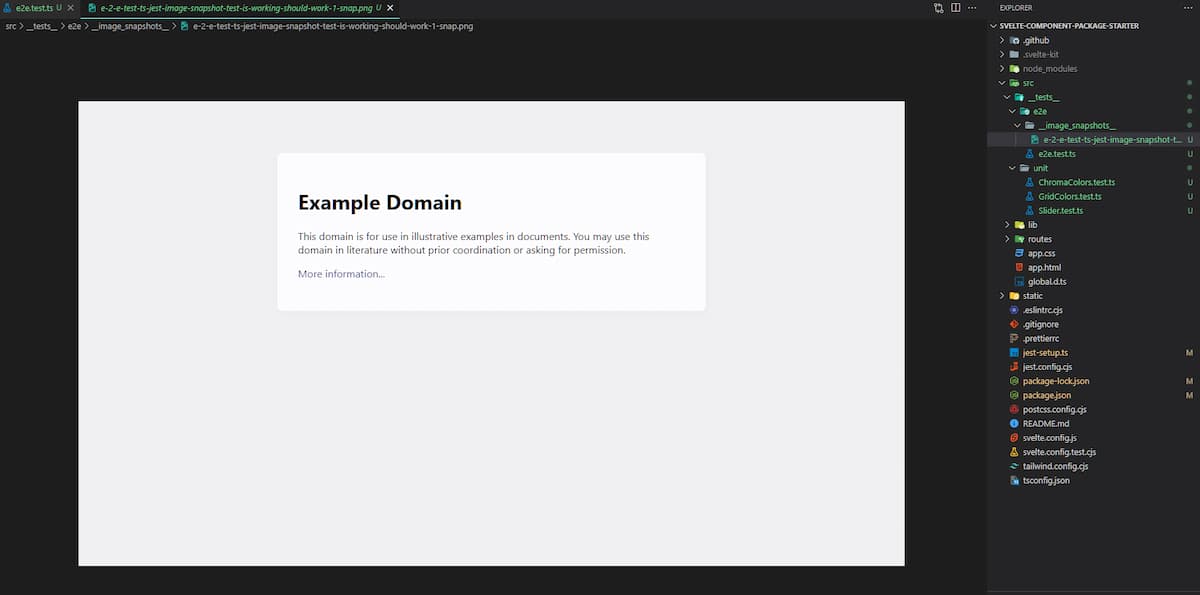
Obviously this test is purely didactic: I need it to understand how to use this tool. I change the address of the page to open (use www.google.com). I rerun the test and I get
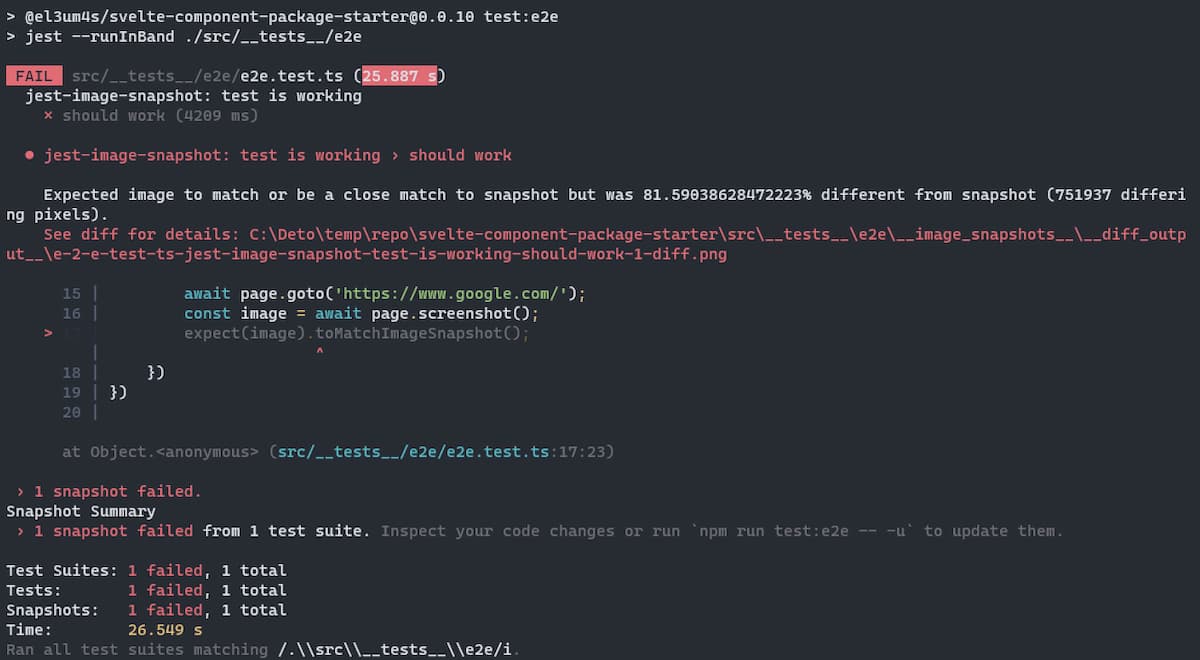
A new __diff_output__ folder has also appeared with an image inside:

Differences between one image and another are highlighted in red. Being two completely different pages, almost everything is red.
I pretend for a moment that the new page is correct and that the differences are intentional. To pass the test I have to update the screenshot. I create a script that simplifies my work:
"test:e2e-update": "jest --runInBand --updateSnapshot ./src/__tests__/e2e",
I run the script:
npm run test:e2e-update
Now my reference page has become:
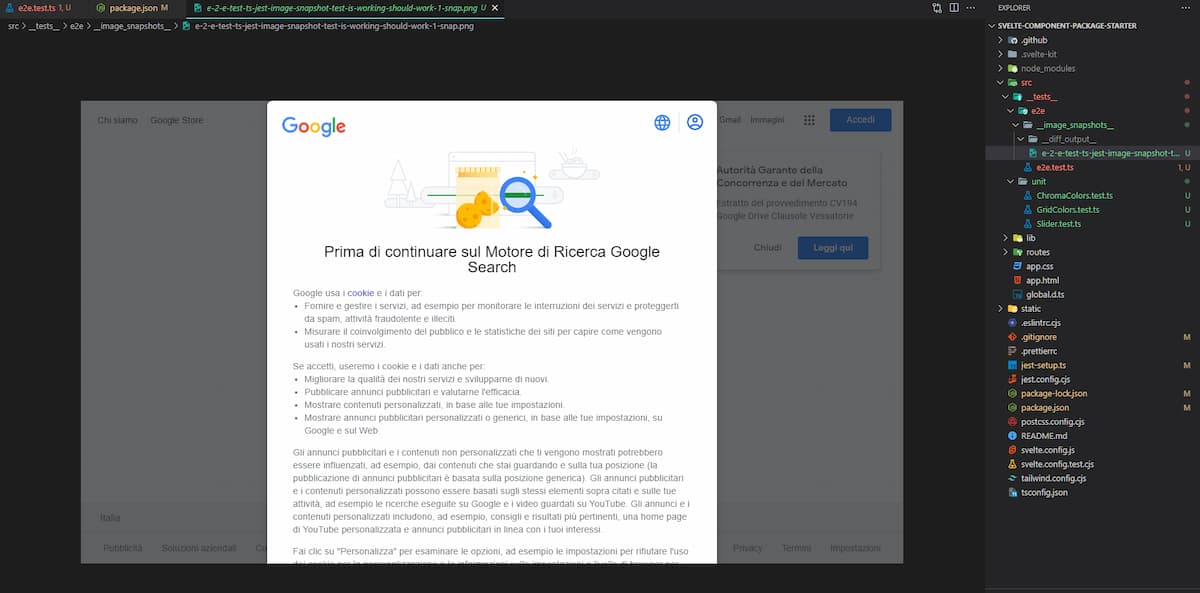
This time by repeating the npm run test: e2e I get no errors.
Create a custom test
Now is the time to write a more useful test. I create a src/routes/test.svelte page dedicated to testing:
<script lang="ts">
import GridColors from '$lib/components/GridColors.svelte';
import { stringToColorStyle } from '../lib/functions/ChromaColors';
const settings = {
firstColor: 'khaki',
secondColor: 'teal',
steps: 9
};
settings.firstColor = stringToColorStyle(settings.firstColor).hex;
settings.secondColor = stringToColorStyle(settings.secondColor).hex;
let borderColor = 'orange';
$: settings.firstColor = stringToColorStyle(settings.firstColor).hex;
$: settings.secondColor = stringToColorStyle(settings.secondColor).hex;
const changeBorderColor = () => (borderColor = borderColor === 'orange' ? 'green' : 'orange');
const changeFirstColor = () =>
(settings.firstColor =
settings.firstColor === stringToColorStyle('khaki').hex ? 'tomato' : 'khaki');
const changeSecondColor = () =>
(settings.secondColor =
settings.secondColor === stringToColorStyle('teal').hex ? 'dimgray' : 'teal');
const reset = () => {
settings.firstColor = 'khaki';
settings.secondColor = 'teal';
settings.steps = 9;
};
</script>
<main>
<h1>Visual Regression Test</h1>
<p>Use this page to test component graphics changes</p>
<div id="grid-colors">
<GridColors {...settings} --border-color={borderColor} />
</div>
<section>
<button id="change-border-color" on:click={changeBorderColor}>Change border color</button>
<button id="change-first-color" on:click={changeFirstColor}>Change first color</button>
<button id="change-second-color" on:click={changeSecondColor}>Change second color</button>
<div>
<span>Steps:</span>
{#each Array(23) as array, i}
<label>
<input type="radio" bind:group={settings.steps} value={i + 2} />
{i + 2}
</label>
{/each}
</div>
<button id="reset" on:click={reset}>Reset</button>
</section>
</main>
<style lang="postcss">
#grid-colors { @apply mb-2 mt-2; }
main { @apply overflow-y-auto; }
section { @apply flex flex-col space-y-1; }
</style>
I inserted various buttons and controls to test my component in various situations. I modify the e2e.test.ts file to refer to the test page:
import { Browser, chromium } from 'playwright';
describe('visual regression test', () => {
let browser: Browser;
beforeAll(async () => {
browser = await chromium.launch();
});
afterAll(async () => {
await browser.close();
});
test("test page", async () => {
const page = await browser.newPage();
await page.goto('http://localhost:3000/test');
const image = await page.screenshot();
expect(image).toMatchImageSnapshot();
})
})
And I run the test with the command npm run test: e2e.
I’m not interested in a static screenshot, I’m interested in seeing what happens when I change the various parameters. Then I add an action to automatically click on various buttons, record the screen and then compare the result.
test("test page", async () => {
const page = await browser.newPage();
await page.goto('http://localhost:3000/test');
const image = await page.screenshot();
expect(image).toMatchImageSnapshot();
await page.click('text=Change border color');
let changeBorder = await page.screenshot();
expect(changeBorder).toMatchImageSnapshot();
await page.click('text=Change border color');
changeBorder = await page.screenshot();
expect(changeBorder).toMatchImageSnapshot();
})
I create tests for all buttons and controls in a similar way.
After fixing the tests I can go back to editing the code. The nice thing is that I do something wrong, or if something unexpected happens, I can get a warning and quickly realize that something is wrong:
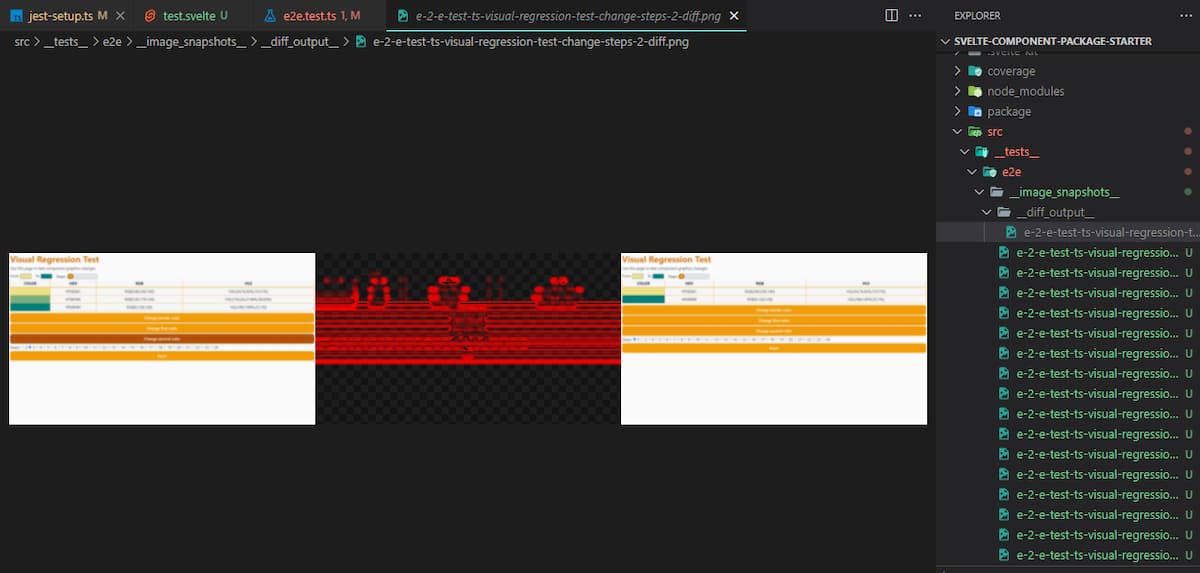
Another interesting thing is that the screenshots give a good idea of the characteristics of the component and almost serve as documentation:
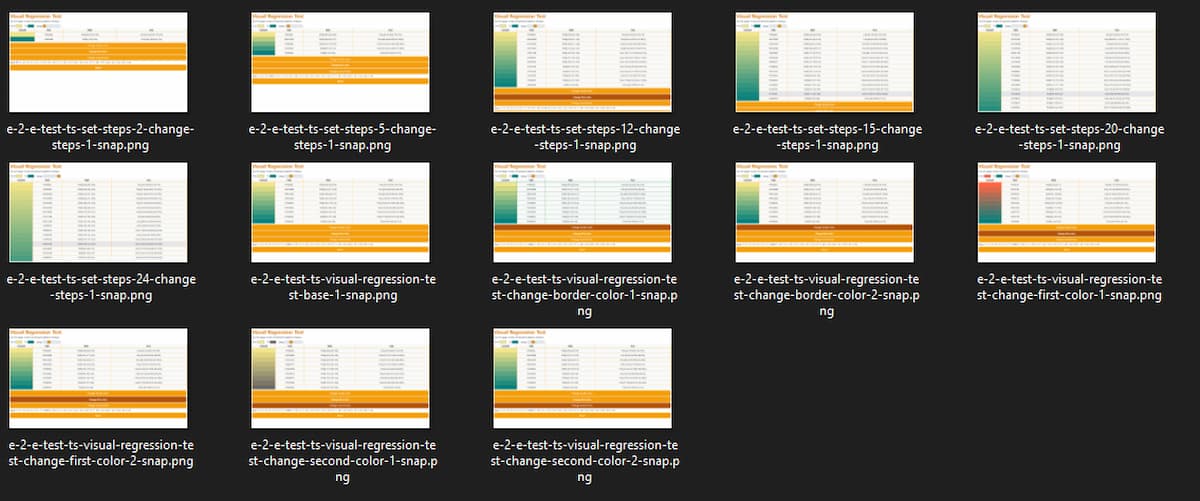
That’s all. As usual, you can see the repository code at el3um4s/svelte-component-package-starter.



